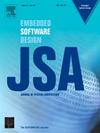LODAP: On-device incremental learning via lightweight operations and data pruning
IF 4.1
2区 计算机科学
Q1 COMPUTER SCIENCE, HARDWARE & ARCHITECTURE
引用次数: 0
Abstract
Incremental learning, which enables a deployed model to continually learn new classes over time, is becoming increasingly crucial for industrial edge systems, where communicating with remote servers for computation-intensive training is often difficult. As edge devices are expected to continue learning more classes after deployment, designing efficient on-device learning frameworks is essential. In this paper, we propose LODAP, a lightweight on-device incremental learning framework for edge systems. The key part of LODAP is a new module, namely Efficient Incremental Module (EIM), which combines normal convolutions with lightweight operations. During incremental learning, EIM employs adapters to effectively and efficiently learn features for new classes to improve the accuracy of incremental learning while reducing model complexity and training overhead. To further improve efficiency, LODAP integrates a data pruning strategy that removes redundant training samples, significantly lowering the training cost. We conducted extensive experiments on the CIFAR-100, Tiny-ImageNet, and CUB-200-2011 datasets. Experimental results show that LODAP improves the accuracy by up to 4.32% over existing methods while reducing around 50% of model complexity. In addition, evaluations on real edge systems demonstrate its applicability for on-device machine learning. The code is available at https://github.com/duanbiqing/LODAP.
LODAP:通过轻量级操作和数据修剪在设备上进行增量学习
增量学习使部署的模型能够随着时间的推移不断学习新的课程,对于工业边缘系统来说变得越来越重要,因为在工业边缘系统中,与远程服务器进行计算密集型培训的通信通常很困难。由于边缘设备预计将在部署后继续学习更多课程,因此设计有效的设备上学习框架至关重要。在本文中,我们提出了LODAP,一个用于边缘系统的轻量级设备上增量学习框架。LODAP的关键部分是一个新的模块,即高效增量模块(EIM),它将正常卷积与轻量级操作相结合。在增量学习期间,EIM使用适配器来有效和高效地学习新类的特征,以提高增量学习的准确性,同时降低模型复杂性和训练开销。为了进一步提高效率,LODAP集成了一种数据修剪策略,可以删除冗余的训练样本,从而大大降低了训练成本。我们在CIFAR-100、Tiny-ImageNet和CUB-200-2011数据集上进行了广泛的实验。实验结果表明,LODAP比现有方法的准确率提高了4.32%,同时将模型复杂度降低了50%左右。此外,对真实边缘系统的评估证明了其对设备上机器学习的适用性。代码可在https://github.com/duanbiqing/LODAP上获得。
本文章由计算机程序翻译,如有差异,请以英文原文为准。
求助全文
约1分钟内获得全文
求助全文
来源期刊

Journal of Systems Architecture
工程技术-计算机:硬件
CiteScore
8.70
自引率
15.60%
发文量
226
审稿时长
46 days
期刊介绍:
The Journal of Systems Architecture: Embedded Software Design (JSA) is a journal covering all design and architectural aspects related to embedded systems and software. It ranges from the microarchitecture level via the system software level up to the application-specific architecture level. Aspects such as real-time systems, operating systems, FPGA programming, programming languages, communications (limited to analysis and the software stack), mobile systems, parallel and distributed architectures as well as additional subjects in the computer and system architecture area will fall within the scope of this journal. Technology will not be a main focus, but its use and relevance to particular designs will be. Case studies are welcome but must contribute more than just a design for a particular piece of software.
Design automation of such systems including methodologies, techniques and tools for their design as well as novel designs of software components fall within the scope of this journal. Novel applications that use embedded systems are also central in this journal. While hardware is not a part of this journal hardware/software co-design methods that consider interplay between software and hardware components with and emphasis on software are also relevant here.
 求助内容:
求助内容: 应助结果提醒方式:
应助结果提醒方式:


